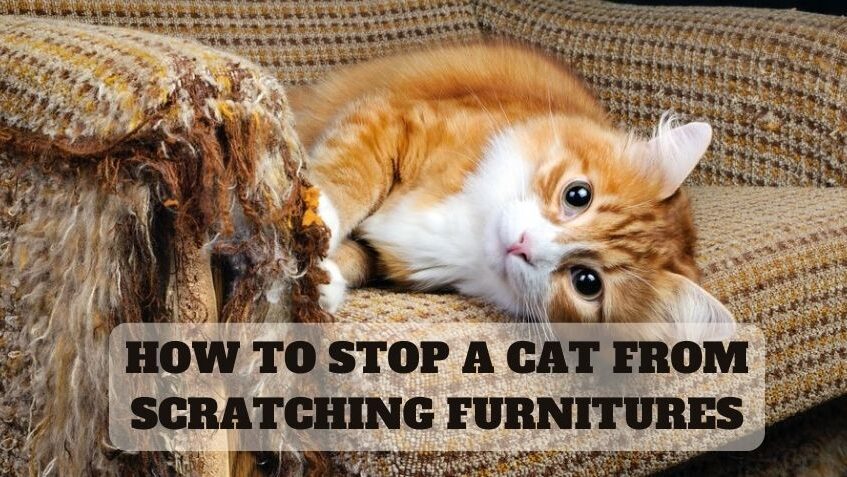HOW TO STOP A CAT FROM SCRATCHING FURNITURES

Cats clawing on furniture and other household furnishings may be purely destructive behavior from your point of view but not from the cat’s point of view. To them it’s natural behavior, following a need to keep their claws in top shape and to leave visual and scent markings on the object, communicating territory boundaries to other cats and other animals.
A cat doesn’t scratch to give you grief. A cat scratches because it’s a form of exercise for the cat’s muscles from the claws right through to the legs, shoulders, and down the back.
Scratching also sharpens the cat’s claws and cleans the exterior sheath.
TIPS TO CURB CATS SCRATCHING

Understand Your Cat’s Need to Scratch
Whether we like it or not, scratching is an innate feline behavior that cannot be prevented—in fact, even declawed cats still “scratch!”
While it may be tempting to scold your cat the next time he sinks his nails into your couch, remember, he’s not acting out of spite. Scratching provides exercise, anxiety relief, and a good stretch—not to mention it keeps kitty’s claws in top shape. Instinctively, cats also scratch to mark their territory
Teach Him What Not to Scratch
Behavior modification consists of teaching your cat to avoid certain scratching sites while helping him to enjoy scratching on appropriate surfaces. It is always best to develop good habits early, but don’t let that discourage you—retraining is possible, even in senior cats!
Show your cat which areas are off-limits by making them less inviting. Consider temporarily covering furniture with double-sided sticky tape or aluminum foil, or spritzing your cat’s favorite scratching spots with an unpleasant scent, like citrus, or a deterrent spray.
Provide (Many) Alternatives
Remember that all cat scratching preferences are different, so the first step will be figuring out what your cat likes. Ultimately, you will want to provide alternatives that most closely resemble the unwanted objects your cat loves to scratch.
Watch his behavior closely—does he like to scratch the seat of your armchair or does he prefer the wooden legs of your dining room table? This can provide valuable clues about his preferences, which you can use to successfully redirect his habits.
If you’re not sure, start by offering multiple scratching materials and experimenting with different sizes, angles, and locations.
Encourage your cat to scratch on appropriate surfaces by making them irresistible. If your cat seems uninterested in the scratching options you’ve provided, try placing catnip, toys, or treats near or on the scratching surface. If he scratches or paws at the surface, quickly reward him with a treat.
Train your cat to use the scratching post
Purchase at least one scratching post (or other scratching apparatus) for your cat. A scratching post is the answer to your scratching problem, but it will take time to encourage your cat to use it.
Locate scratching posts strategically. Figure out which pieces of furniture the cat has clawed and their locations. Make sure the scratching apparatus is prominently featured in the room and next to any furniture the cat seems to prefer scratching.
Condition your kitten or cat to use the scratching post and nothing else for scratching. Encourage your cat to unleash his claws on the new scratching post by gently placing him in front of it. At the same time, gently stroke him and wait for him to respond to the post in front of him.
Cover problem furniture
If you have antiques or furniture that is of great value, consider leaving it in a cat-free zone. Ensure that everyone in the family is aware that the cats must not be let into that area or room and always keep doors to these areas closed. Ask the humans in the house to take care rather than expecting the cat to know the difference between important.
Go to the Source
Another way to deter your cat’s destructive scratching is to trim his nails. Start slowly by introducing your cat to having his paws handled. At a time when your cat is calm and relaxed, gently touch his feet and press on each paw pad to extend the nail. Practice this process frequently, only doing as much as your cat will tolerate. It may take a week or two before your cat becomes comfortable enough to allow nail trimming.
When you are both ready, place your cat on your lap facing away from you or enlist a friend to hold your cat while you trim. Gently extend each nail, trim the tips, and repeat every two weeks. It is important to only trim the white tips—the pink portion of each nail contains the quick, which is made up of nerves and blood vessels that cause bleeding and discomfort when cut.
If you think it’s a behavior problem that requires further assistance, visit your veterinarian as early recognition, diagnosis, and treatment are essential.
You may also visit – https://www.facebook.com/angkopparasahayop




